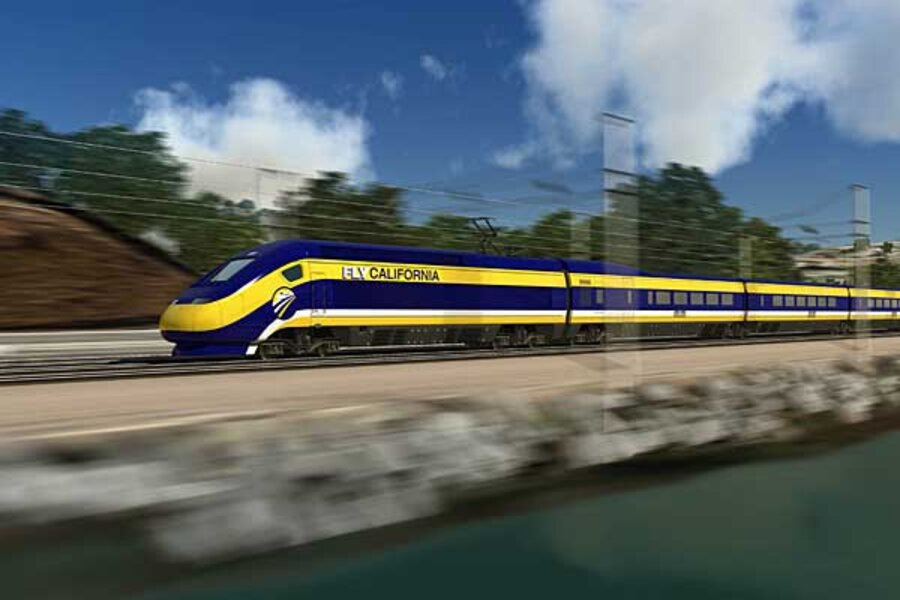Why Jerry Brown is standing firm on shaky California high-speed rail plan
Loading...
| Los Angeles
A new report by the state auditor concludes that California’s proposed $98.5 billion bullet train is “increasingly risky” and has inadequate oversight, adding to a growing pile of formal assessments that raise major concerns about the project.
Three weeks ago, an independent panel required by law to review the plans said the bullet train poses “an immense financial risk.” And in November, California's independent Legislative Analyst’s Office said parts of the plan don’t comply with the 2008 ballot measure that authorized state funding for the project.
Undeterred, Gov. Jerry Brown is pressing ahead, claiming that the train will create jobs, accommodate future population growth, and aid the environment.
In his state-of-the-state address Jan. 15, he said boldly: “During the 1930s, the Central Valley Water Project was called a 'fantastic dream' that 'will not work.' The Master Plan for the Interstate Highway System in 1939 was derided as 'New Deal jitterbug economics.' In 1966, then-Mayor Johnson of Berkeley called [the Bay Area Rapid Transit system] a 'billion dollar potential fiasco.' Similarly, the Panama Canal was for years thought to be impractical and [British Prime Minister] Benjamin Disraeli himself said of the Suez Canal: 'totally impossible to be carried out.' "
"The critics were wrong then and they’re wrong now,” he concluded.
Political analysts say Governor Brown has his eye on history, trying to be mentioned favorably alongside his father, Pat Brown, who was governor from 1959 to 1967 and whose achievements virtually define modern California.
“Governor Brown is seeking to define his legacy, and public mass transportation is one of the things in which he deeply believes,” says Michael Shires, a public policy specialist at Pepperdine University. “The creation of a high-speed rail link would allow him to leave an imprint on the state that is in the same universe as his father's legacy of water projects, universities, and highways.”
The state auditor's report, however, spoke harshly of the plan. It notes that only $12.5 billion of the $100 billion-plus project is secured, with no indication of how the rest is to be obtained. It also claimed that the California High-Speed Rail Authority doesn't have mechanisms in place for monitoring its contractors.
Supporters of the project say the 220-m.p.h. trains will transform transportation in the state and create jobs. The move is also shrewd politically for Brown, helping him with unions, who helped elect him and whose support he needs for a tax-hike initiative this fall, analysts say. Plus, touting rail has very little downside for now.
“Particularly during a difficult recession, reminding voters of long term makes him look like a visionary,” says Dan Schnur, director of the Jesse M. Unruh Institute of Politics at the University of Southern California.
It was the Obama administration, he and others note, that last year pushed the idea of a national, high-speed rail network.
“The last thing the White House wants is to be undermined by a Democratic governor of California, so it doesn’t cost Brown anything to talk up high-speed rail,” says Mr. Schnur.
But Republicans are calling for a stop to the project, and opponents have been cleared to begin a signature-gathering drive aimed at putting an anti-rail initiative on the ballot.
“This is a train to nowhere, the Governor Moonbeam express,” says Assemblywoman Diane Harkey, invoking the pejorative nickname given to Brown in his first term by Chicago journalist Mike Royko, who thought Brown’s wild ideas were appealing only to a New Age crowd.
She says part of the reason Brown doesn’t want to back off now is because $3.5 billion that has already been designated by the Obama administration includes funding for a project in Rep. Nancy Pelosi’s district.
She also questions the ridership and cost figures.
“They are playing lots of shenanigans, like counting one man who is a potential ticket taker for 20 years as 20 jobs,” says Ms. Harkey.
Some national observers are worried what the California episode might mean for high-speed rail elsewhere.
“There were enough objective critics of this program back when it was first proposed that predicted we would find ourselves in this spot today,” says Peter Zaleski, an economics professor at the Villanova School of Business in Philadelphia, who follows transportation issues. “Opponents will use the current report as evidence to support the case that we never should have moved forward on this project. I fear that proponents will view this as just another hurdle and rationalize the need to push forward.”
The questions may all be moot if funding can’t be found.
“Fiscal problems are putting many spending ideas on hold in Washington and state capitals, and California high-speed rail may well join other programs on the shelf due to lack of financing,” says Steven Schier, political scientist at Carleton College in Northfield, Minn. “The plain fact is that high-speed rail is so expensive that it is necessary for a state to be in sound fiscal shape in order to fund it. California unfortunately is not in such shape now and won’t be anytime soon.”
“Californians have a tradition of committing funds first and thinking about who will pay later,” says Ken Button, a transportation specialist at George Mason University in Fairfax, Va.
It may come down to a combination of what the California economy does in the next few months and Jerry Brown’s skills as a politician.
“If he pulls it off, he’ll go down as a visionary,” writes columnist Dan Walters in the Sacramento Bee. “If it fails, he'll go down as a narcissistic daydreamer."





